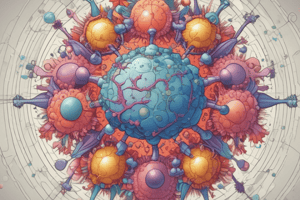Podcast
Questions and Answers
Which molecules recognize class I MHC molecules?
Which molecules recognize class I MHC molecules?
- CD4
- CD8 (correct)
- ζ chains
- CD3
What happens to naive T cells after migrating to peripheral lymphoid organs?
What happens to naive T cells after migrating to peripheral lymphoid organs?
- They recognize antigen
- They migrate to any site of infection
- They differentiate into memory cells (correct)
- They become effector cells
What is the role of adhesion molecules in T cell migration?
What is the role of adhesion molecules in T cell migration?
- They increase the affinity for their ligands in response to antigen recognition (correct)
- They deliver necessary second signals for T cell activation
- They recognize microbial antigens
- They express costimulators on APCs
What happens to effector T cells generated in lymphoid organs?
What happens to effector T cells generated in lymphoid organs?
What is the role of costimulators on APCs?
What is the role of costimulators on APCs?
What is the fate of naive T cells after antigen elimination?
What is the fate of naive T cells after antigen elimination?
What is the role of CD3 and ζ chains?
What is the role of CD3 and ζ chains?
What is the fate of effector T cells in tissues?
What is the fate of effector T cells in tissues?
What is the role of chemokines in T cell migration?
What is the role of chemokines in T cell migration?
What is the role of APCs in T cell activation?
What is the role of APCs in T cell activation?
Study Notes
T Cell-Mediated Immunity
- T lymphocytes play a crucial role in defending against infections by various kinds of microbes, particularly those that live and reproduce inside host cells. T cells recognize and eliminate infected cells, thereby removing the source of infection, thereby protecting the host from further harm.
- T cells also provide defense against infections by extracellular microbes, such as bacteria and fungi, which are readily destroyed by phagocytosis, especially by neutrophils.
- In some cases, T cells collaborate with B cells to produce antibodies, which provide a long-term defense against specific pathogens.
Cell-Mediated Immunity
- Cell-mediated immunity provides defense against infections by microbes that live and reproduce inside host cells, including viruses, some bacteria, fungi, and protozoa. This type of immunity is crucial for eliminating infected cells and removing the reservoir of infection.
- The process of cell-mediated immunity involves the activation and proliferation of T cells in response to specific antigens presented by antigen-presenting cells (APCs). Activated T cells then recognize and eliminate infected cells, thereby removing the source of infection.
- Cell-mediated immunity also plays a crucial role in defense against cancer cells, where T cells specifically recognize and eliminate tumor cells.
Types of Intracellular Microbes
- Viruses are among the most common types of intracellular microbes that infect host cells, replicating in the nucleus and cytosol of infected cells.
- Rickettsiae are obligate intracellular parasites that reside in non-phagocytic cells, requiring the presence of host cells to survive.
- Protozoa are another type of intracellular parasite that can infect host cells, with some species exhibiting obligate intracellular behavior.
Extracellular Microbes
- Extracellular microbes, such as bacteria and fungi, are often readily destroyed by phagocytosis, a process mediated by neutrophils and other phagocytic cells.
- Helminthic parasites, on the other hand, are typically eliminated by special types of leukocytes, such as eosinophils.
Line of the Immune Response
- Antigen-specific lymphocytes, including T cells and B cells, expand during an immune response, recognizing and responding to specific antigens.
- As the immune response subsides, many T cells die by apoptosis, allowing for the elimination of activated immune cells and the return of the immune system to a state of homeostasis.
- A pool of surviving memory lymphocytes remains, allowing for rapid responses to subsequent encounters with the antigen.
T Cell Functions
- T lymphocytes mediate defense against microbes that live within host cells, some extracellular microbes, and cancer cells, recognizing and eliminating infected and tumor cells.
- T cells also collaborate with B cells to produce antibodies, providing long-term immunity against specific pathogens.
T Cell Activation and Signaling
-
T cells recognize antigen through the TCR (CD3 and ζ chains) and coreceptors CD4 and CD8, which recognize class II and class I MHC molecules, respectively.
-
The binding of T cells to APCs is enhanced by adhesion molecules, such as integrins, whose affinity for their ligands is increased by antigen recognition.
-
T cell activation and signaling are tightly regulated through a complex interplay of molecular interactions, ensuring proper immune responses and preventing autoimmunity.
-
Activated T cells differentiate into memory cells, which survive even after the antigen is eliminated.
-
Signaling pathways involve protein tyrosine kinases, which phosphorylate proteins that become docking sites for additional kinases and other signaling molecules.
Studying That Suits You
Use AI to generate personalized quizzes and flashcards to suit your learning preferences.
Description
This quiz covers the basics of T cell-mediated immunity, including the functions of T lymphocytes in defending against infections and their role in cell-mediated immunity.




